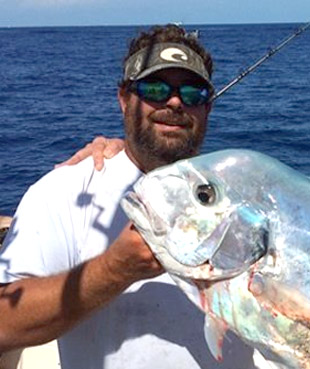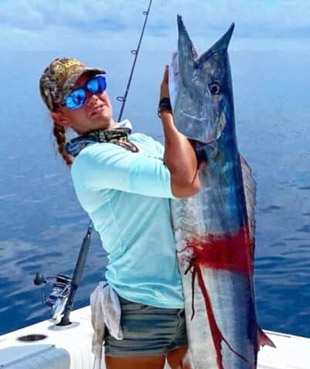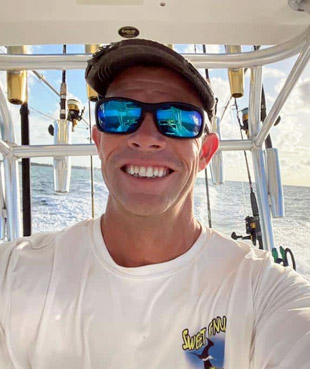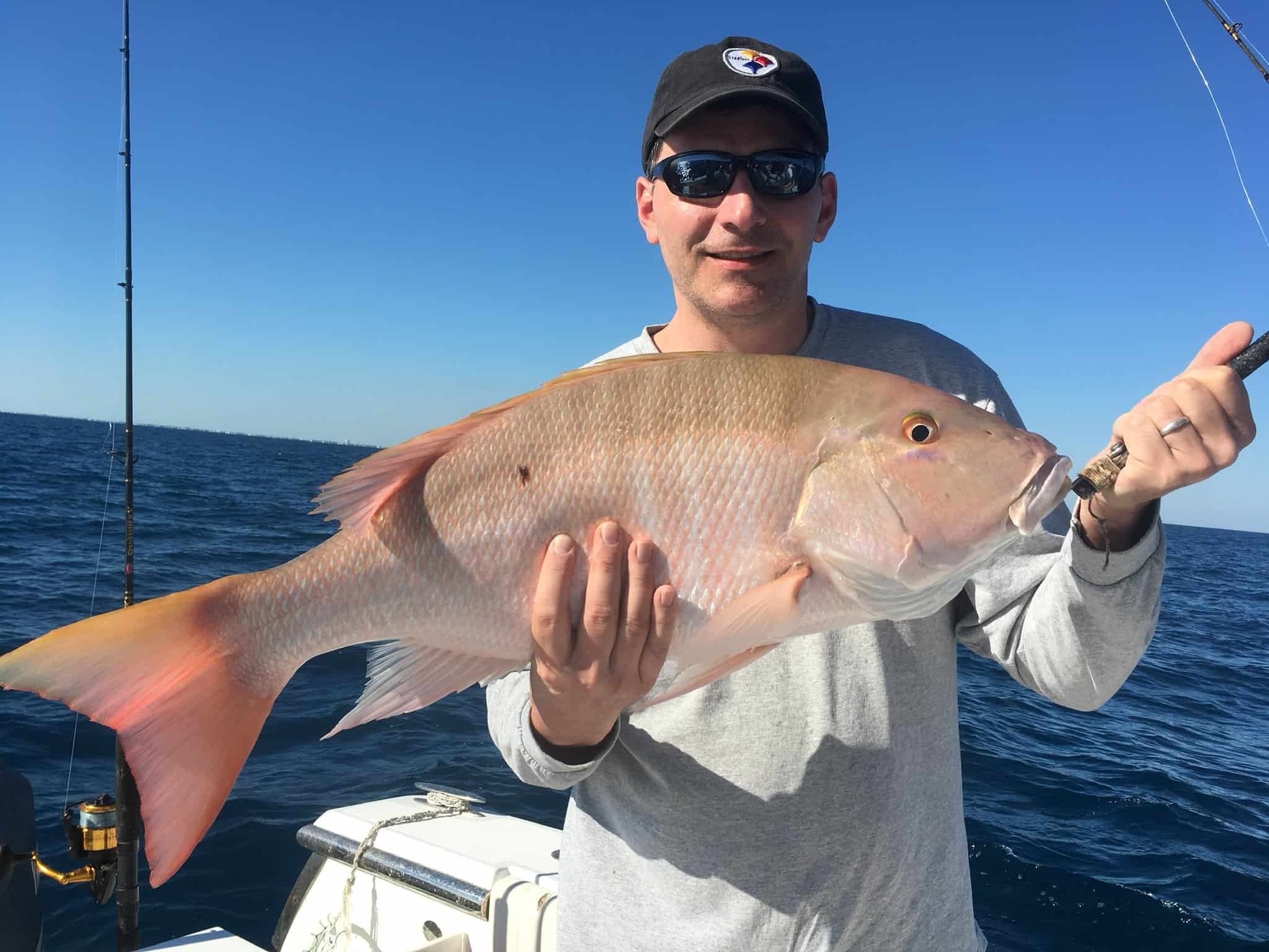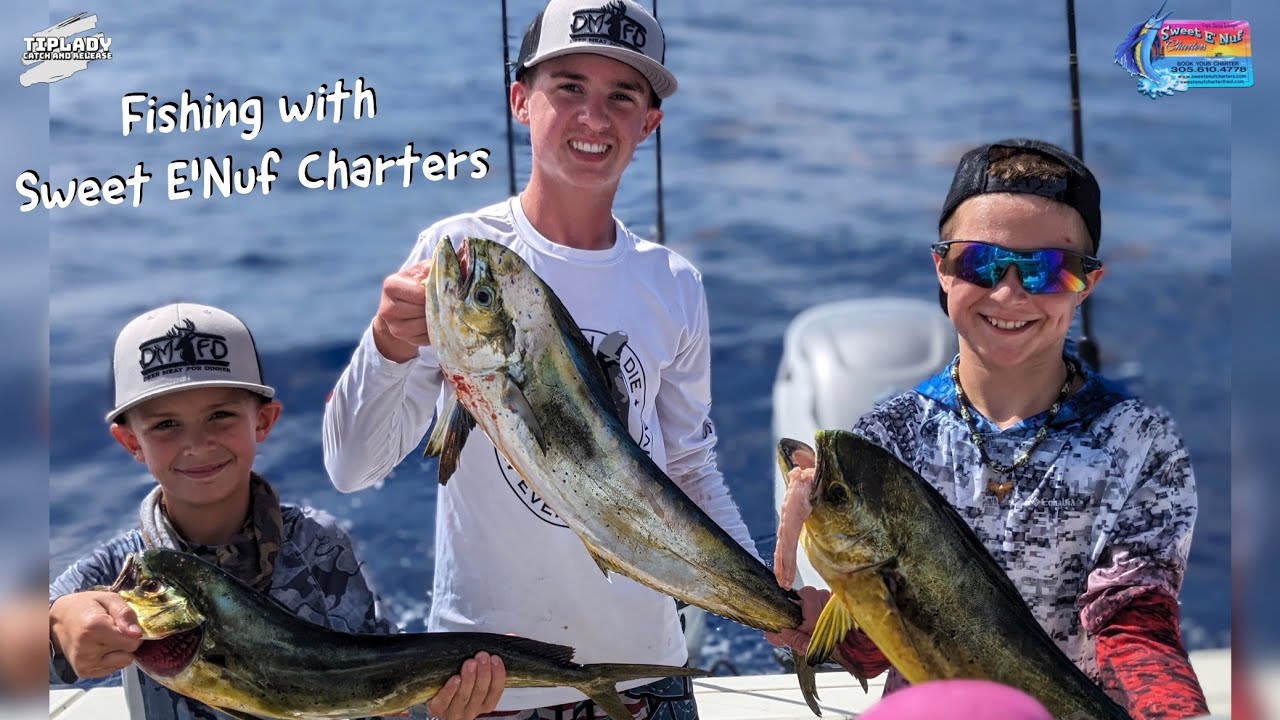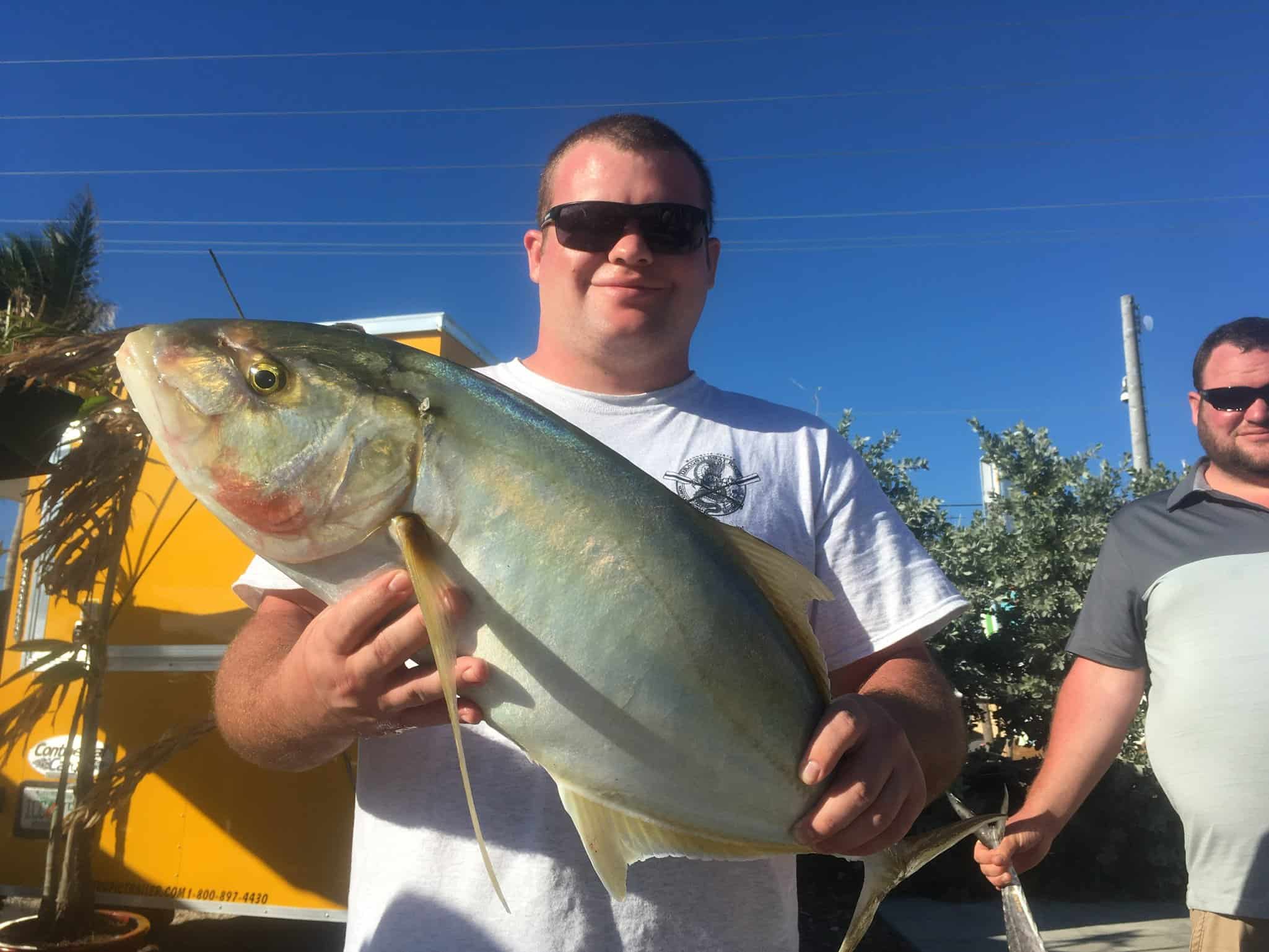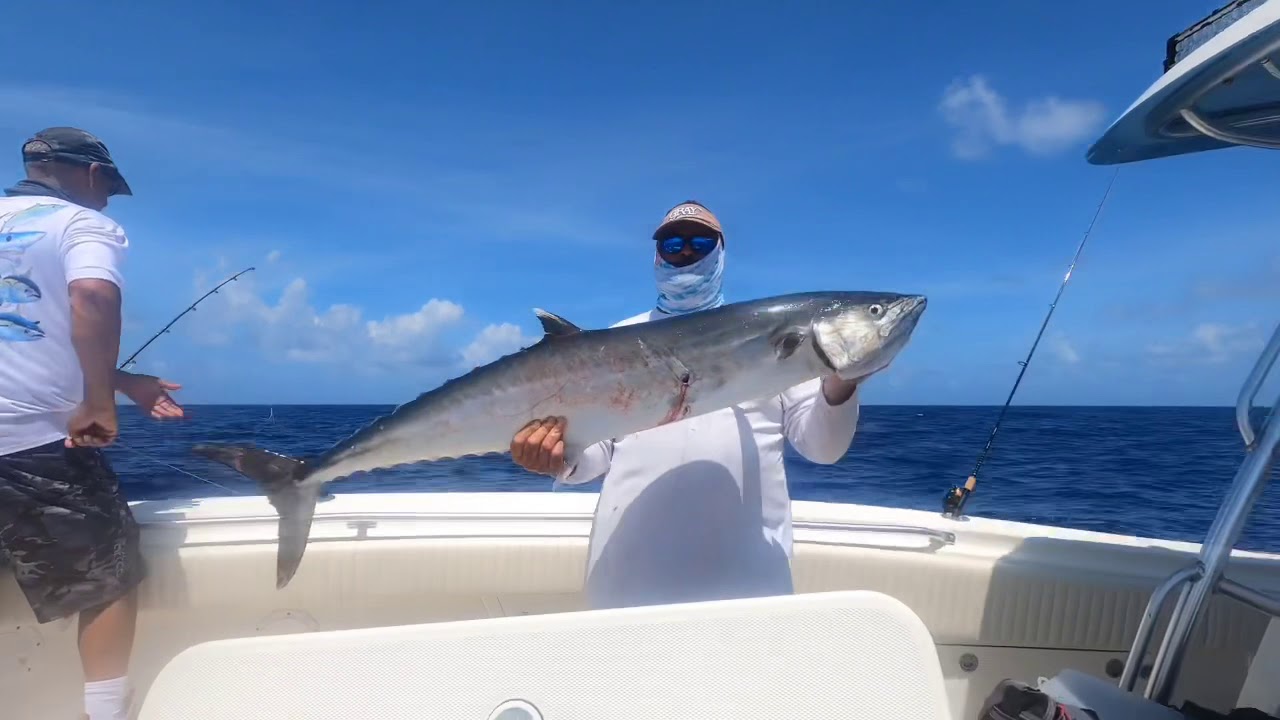Fishing Where the Sun Don’t Shine: Equipment, Rigs, & Species.
The fastest growing fishing industry has been the deep dropping with electric reels. In the past ten years this fishery has absolutely exploded. Reel manufactures have been busy to keep up with each other as new functions and new design breakthroughs, let anglers reach new depths of the ocean with ease.
Break out your checkbook because new technology isn’t cheap, ranging from $1,000 to $4,700 for a reel was the norm. More than a decade has passed since the explosion of electric reel enthusiast’s and the price for the new and improved reels have finally started to come down. What was $1,000 is now $600 and what was $4,700 is now $3,500.
The pros and cons of the major reels we use will determine which ones we will buy. I will break down a few pros and cons and you determine which reel is the best for you.
Part I: Deep Drop Rods – Pros and Cons
- Daiwa 1000
- Daiwa 3000
- Hooker Electric w/ Shimano Tiagra TI80WA Reel
- Kristal Fishing w/ Electric XL655 XF-Xtreme Reel
- Dolphin Electreel w/New Shimano Tiagra 80WA
Daiwa 1000
Price $600
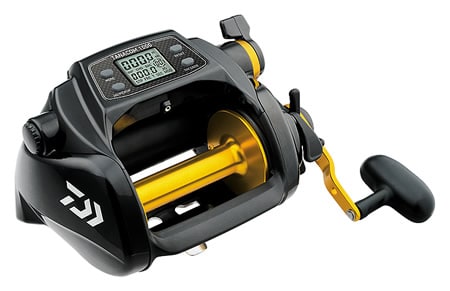
| Pros | Cons |
|---|---|
| Light Weight | Poor Torque |
| Safety Stop | Body is Plastic |
| Medium Retrieval Speed | Dropping you have to pull back on the spool to Disengage |
| Line Counter | |
| Line Capacity | |
| Line Guider |
Recommended Use: This reel is great for deep dropping for bottom fish but not swords, but limited to 1200-1500 feet of water which covers most species of bottom fish but not all.
Daiwa 3000
Price $3,500
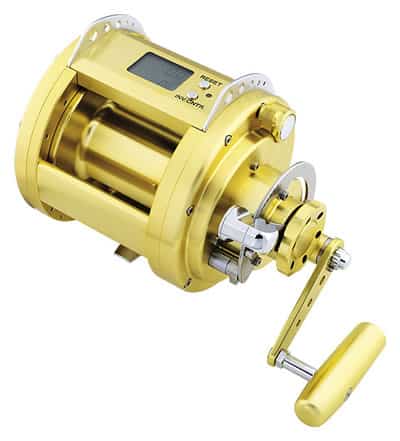
| Pros | Cons |
|---|---|
| Huge Line Capacity | Slow Retrieval Rate |
| Tremendous Torque | Heavy |
| Line Counter | |
| Line Guider | |
| Safety Stop | |
| Aluminum Body |
Recommended Use: This reel can be used for any deep water application but because it is so slow it takes forever to come up from really deep depths, it can be used and I like using it because of the line counter, and line guider, but since it is so slow your wasting time waiting for the rig to be retrieved.
Hooker Electric w/ Shimano Tiagra TI80WA Reel
Price $3,999
| Pros | Cons |
|---|---|
| Fast Line Retrieval | Heavy |
| High Torque | No Line Counter |
| Line Capacity | No Line Guider |
| Aluminum Body | No Safety Stop |
Recommended Use: The Hooker comes in different sizes but depending on your application, the most common size is this one as it can be used for bottom fish and swordfish. It is very fast and has lots of torque for putting the screws to the fish especially in the Bahamas where sharks are very numerous. If you weren’t interested in sword fishing at all I would recommend their 30/0-50/0 reels. Now if you are a Penn guy I do believe the hooker can be rigged with Penn International as well with the Shimano Tiagra.
Kristal Fishing w/ Electric XL655 XF-Xtreme Reel
Price $3,450
| Pros | Cons |
|---|---|
| High Torque | No Line Counter |
| High Retrieval Speed | No Line Guider |
| Composite Body | No Assist Handle |
| Tremendous Line Capacity | Heavy |
Recommended Use: Kristal reels are strictly deep dropping rigs with no handles, which if your electric reels stops for some reason you have no way of getting the line back on the reel effectively. They come in all sizes depending on your application. Most people get the largest or second to largest model so they can fish for whatever at any depth. The Kristal is the only reel out there that I am aware of that has a composite body and levers which is great on corrosion. Salt water is extremely caustic and in time eats all metals.
Dolphin Electreel w/New Shimano Tiagra 80WA
Price $3,170
| Pros | Cons |
|---|---|
| High Torque | No Line Guider |
| Line Capacity | No Line Counter |
| Aluminum Body | Bulky, Heavy |
| Assist Handle |
Conclusion: I hope this comparison will help you on your next purchase and these are only a few. There are many different sizes for electric reels and depending what you plan on doing with it will determine which size best suits your needs. The bigger the electric reel, the more expensive it is as in most reels. The biggest electric reels are mainly used for sword fishing as it is overkill on torque and line capacity for fishing waters less than 800 feet. The smaller reels will be fine for most deep dropping applications for snappers, groupers and tilefish.
Fishing where the sun doesn’t shine may not be for you, but catching fish only other people get to read about is part of the fun. The other part is eating them as almost all of these deep water species are fantastic table fare.
Part II: Deep Drop Species & The Rigs to Catch Them
Blue Line Tilefish
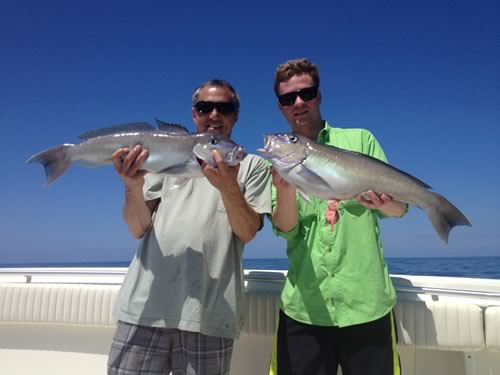
Blue Line Tilefish can be found near or on rock ledges or humps from Depths of 700-450 feet of water. I find that their favorite bait is squid, but they will eat just about any kind of fish. Their average sizes here in the Keys are 5-8 pounds with big ones up to 15 pounds are caught but infrequently. As far as food fair the smaller ones are by far better than the larger ones and they would be at the bottom of the chart from the best tasting to worst tasting deep drop fish. But by any means they still are better than yellowtail snapper, so they still are very good eating.
When fishing for them I will use small hooks usually 5/0 super mutu because of their small mouth. Even though these fish tend to be small they fight pretty good all the way to the surface, and if you lay your rig down and utilize all the hooks on your rig you may get a full stringer or at least three and then the fight is on! When using hand cranks or electric reels deep dropping is fun and you can fill the cooler with great eating fish.
Blue Line Tilefish are considered a grouper when consulting the FWC which lets you take three per angler as long as you still have three open grouper slots in your take still left open. If you had caught a snowy or yellow edge grouper then you would only be able to keep two. Remember that they are considered in your aggregate grouper take.
Golden Tilefish
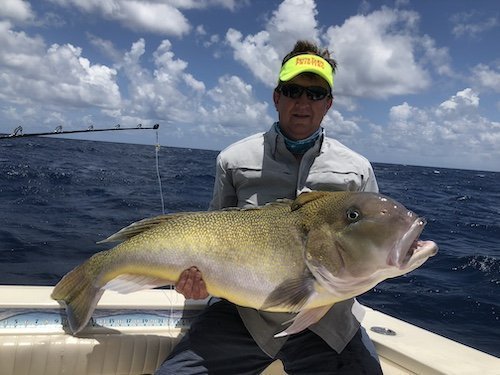
Golden Tilefish are found from 1300-450 feet of water and are located on muddy bottom. They mainly eat squid but will eat other fish, yet squid should be the bait you use to have good success. Unlike most of the deep drop fish, Golden Tilefish are primarily are found on muddy bottoms as it becomes night they burrow into the mud for protection while they sleep. Golden Tilefish are beautiful fish with gold and blue and as they get older they grow a soft horn like appendage on the top of their head which has such a vibrant golden color to it.
As the Blue Line Tilefish the Golden Tilefish are categorized in the grouper aggregate but you are only allowed to harvest one fish per harvester, for instance you could have one Golden Tilefish and two Blue Line Tilefish or one Golden, one Blue Line, and one Snowy. There is no boat limit on Golden’s so you can have one golden per person on the boat.
I generally will use small to medium hooks for Golden’s, 5/0-10/0 circle hooks, and I do prefer the super mutu. Like the Blue Lines, the Goldens do not come off of the bottom to eat so if you lay the rig down on the bottom you are more likely to get multiple hook ups on one drop.
Snowy Groupers
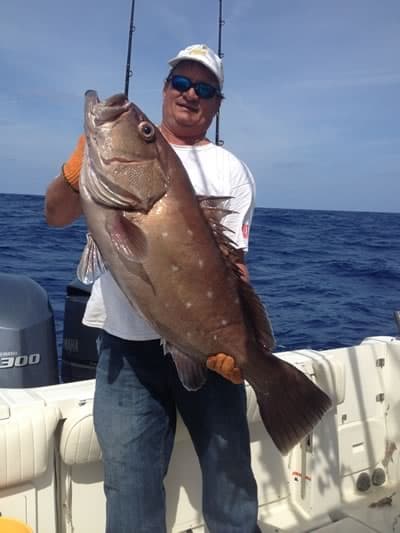
Snowy Groupers are found from 1100-450 feet of water near or on rock, ledges, holes or humps. I prefer to use large circle hooks 14/0-16/0 Mustad old school circle hooks. I use very large baits, such as whole Tinker Mackerel, slabs of Bonita or Skipjack, giant Squid and even fillet of Dolphin fish when the bait is hard to get. Usually Dolphin is already in the box as when I go deep dropping, as we find them on the way to the grounds, but I always bring some sort of bait just in case. Snowy Grouper are a prized catch down here in the Keys because it is so good to eat, one of the best eating fish in the ocean as far as I’m concerned.
Of course Snowy grouper is in the grouper aggregate category and you are only allowed to harvest one per vessel in Federal waters but in State waters you are allowed one per harvester in conjunction with your grouper aggregate. State waters end three miles from any point of land so you’re only going to catch them in Federal waters, but sometimes in Miami to West Palm Beach the deep water is close in where you could catch a snowy in State waters.
A big problem we have sometimes is we catch two Snowy Groupers on the same rig and because we are always in Federal waters we are required to throw back a doomed grouper instead of keeping a second Snowy. It’s the law and we have to follow it even though it’s wasteful. So, on my snowy rigs I usually only have two to three hooks instead of four or five and as soon as I feel the fish is hooked I bring up the rig so not to catch a second accidentally.
Yellow Edge Grouper
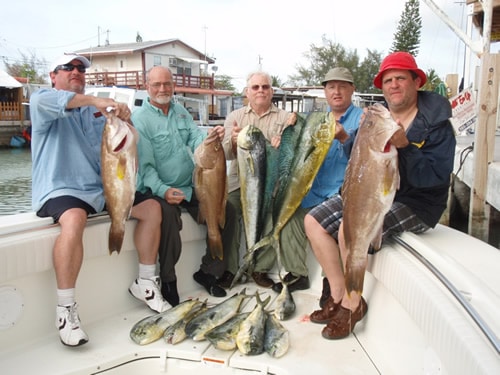
Yellow Edge Grouper are found on or near rock Ledges, holes or humps. Yellow Edge grouper are very similar to the Snowy Grouper except they have yellow edges on their fins. As with the Snowy Grouper, Yellow Edges eat the same bait and I use the same set up for the two fish. Yellow Edge Grouper are mainly found in water depths from 600 feet to 900 feet.
When you catch a Yellow Edge Grouper you will catch more there, unlike the Snowys the Yellow Edge Grouper tend to school up a bit. I still like to use big baits and big hooks as these fish have enormous mouths, and sometimes of the year we get these really small Blackfin Tuna about a pound or two and I will use the whole fish for bait, I just split the tail so the bait swims instead of spinning.
Yellow Edge group taste the same as Snowys, if you were to do a taste test no one would be able to determine which fish was what. For such a similar fish you would think that the regulations would be same, but Yellow Edge Grouper have a one fish per harvester in conjunction with the three fish grouper aggregate limit.
Wreckfish
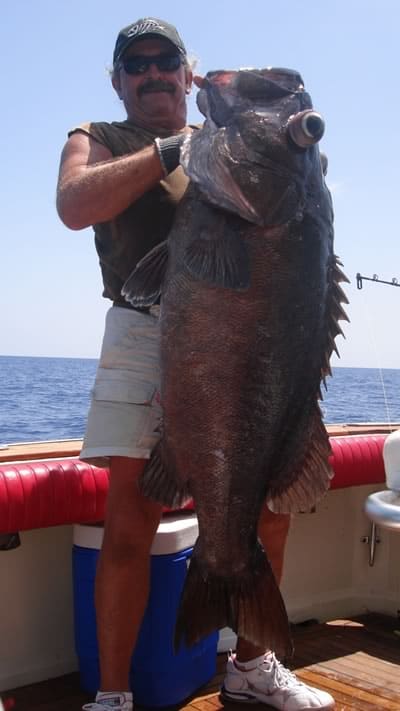
Wreckfish are found from 1100-2600 feet of water on rock ledges, holes, and humps. When fishing for Wreckfish, I use 16/0 circle hooks and huge baits as these fish get big, averagely they weigh in at 60 pounds but can reach a few hundred pounds. When using such large baits you will need to increase you weight size and because of the depth the weight size should be ten to fifteen pounds. And again, because of strict regulations I only drop two to three hooks because this fish you are only allowed to keep one per vessel and it is only open for three months out of the year.
The Wreckfish is categorized in the grouper aggregate even though it’s not a grouper, it’s a member of the sea bass family. I have caught many in the past but in the past few years during the time of year we are allowed to catch them now I haven’t been very successful. Their food fair is ok, but really tough, I like to over cook them on the grill and then dip in drawn butter and it resembles lobster.
Queen Snapper
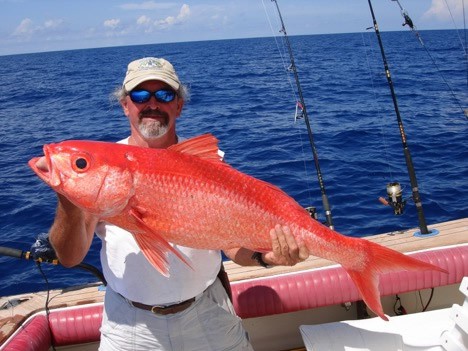
Queen Snapper are found on or near rock ledges, holes and humps. This fish is highly prized for its meat and how beautiful they are. I tend to use big hooks for these not because of the size of their mouth, but because their mouths are soft and hooks tear out easily, so by using larger hooks I’m able to get a deeper bite with the hook to help ensure getting this tasty fish to the boat.
Queen snapper will eat any type of bait, most people use squid, but I like to have an assortment of different types of bait on the same rig with four to five hooks, as queen snapper are like most snappers, great at getting the bait off the hook without getting hooked.
The Queen Snapper is probably the best eating fish we have here in South Florida and they are quite numerous during the fall and winter months, as we get into the spring all of these fish leave and go somewhere, probably Mexico as that is the only place I have seen queen snapper of this quality like my long time fishing buddy Andy Payne is holding up in this photo of a twenty five pound specimen.
Currently we are allowed ten fish per angler but we never reach our limit as the time it takes to get down to the bottom and hook and bring back one to two fish at a time there just isn’t enough time in the day to get your limit. When these fish are in our area they are also followed by large sharks, so beating the sharks and trying not to pull them off the hook a lot of times we don’t get one every drift.
Unlike the deep water groupers and tilefish, queen snapper migrate long distances, because when they leave the Keys they are nowhere to be found in South Florida, except for a couple here and there. The majority of them leave our vicinity and are out of reach of us Keys fisherman.
Escolar
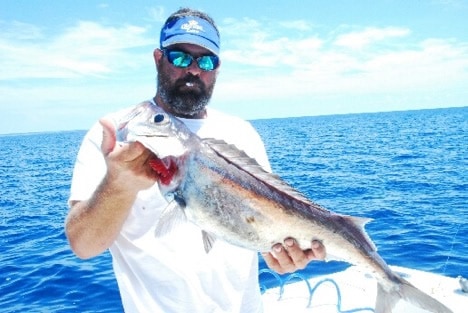
Escolar can be found in 1300-2600 feet of water on rock and sandy bottoms. Escolar have many different species among their family, this one in the photo is an Escolar Roudi and is found very deep where mainly their only food are Anglerfish, Scaled Dragonfish, squid and many other deep water species most people have never heard about unless you watch the Discovery channel.
When fishing that deep I like to use squid and barracuda. I love squid for dropping because that is the natural forage fish these deep water species are accustomed to eating, and I like barracuda because of its tough skin, it is really hard for the fish to get it off the hook and also because it’s so stinky.
I generally use large hooks when dropping that deep as most of the fish even when they are small have big mouths. I will use 14/0-16/0 hooks with four to five hooks on my rig fishing this deep.
Escolar is quite common fish to find in a sushi restaurant otherwise you will almost never see it on the menu. It is a very oily fish and not great to cook. Some people will have a different opinion but that’s why there are so many fish to choose from.
Usually you don’t target Escolar, but instead it’s an accidental catch while fishing for other deep water species in the Florida Keys. When fishing ledges and humps, lots of different deep water species congregate there for many reasons, one being food, and others like the cover.
Yellow eye and Blackfin Snapper
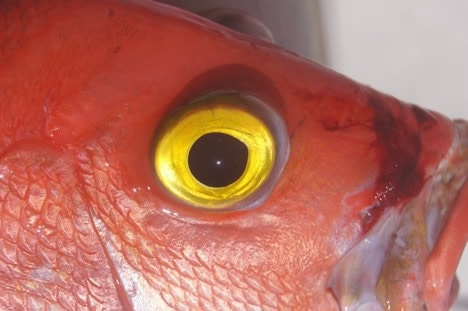
Yellow eye and Blackfin Snapper can be found from 400-1000 feet of water on rocky walls and humps. Generally found off of Key West and the Bahamas this fish is greatly sought after as its soft snapper fillets are highly prized by anglers.
These fish gather in huge schools so one you found them you should load up. I generally use smaller hooks such as 5/0-8/0 super mutu circle hooks with 5-10 hooks on the rigs. These fish a have a distinctive yellow eye and the Black fin Snapper will have black on its body around the pectoral fin.
They are regulated by the 10 snapper aggregate limit. As of now there is no closed season. The best bait is barracuda because they are masters of getting the bait off your hooks, it’s absolutely amazing how efficiently they strip your bait off the hooks without getting hooked.
Barrel Fish

Barrel fish can be found from 700-1200 feet of water on ledges and humps. This is one of my favorite fish in the ocean. I call it chicken of the sea, because of its mild flavor and its unique texture. You can make nuggets out of it and fry like chicken and people who normally wouldn’t eat fish will enjoy it as long as you didn’t tell them it was fish. It has the texture of chicken and I just love it.
I catch them on mainly squid but they will eat cut fish. I use big hooks because like the Queen Snapper they have soft mouths and they fight hard so they tear of the hook fairly easy. Barrel Fish have an unusually thick slime coat, as you hold them for a photo it isn’t uncommon for the slime to actually goop off and hit the deck. Make sure you clean it off as it will become a slip hazard if left on the deck. Currently there are no regulations on them and they are quite plentiful if you can find them.
Misty Grouper
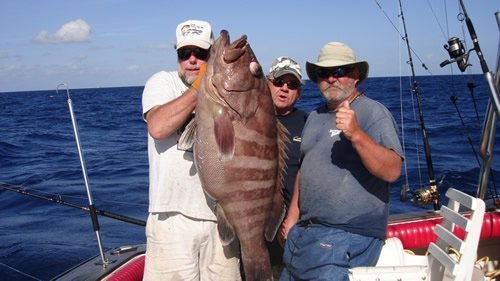
Misty Grouper are found from 700-2000 feet of water on just about all structures. This grouper are primarily found in the Bahamas but occasionally I have caught a few here in the States. They are usually very deep and are found where the Silk Snapper are as that is their natural forage food.
I use big hooks and big baits for them and currently the regulations is one per harvester with conjunction with your grouper aggregate limit. They aren’t the best eating but not bad, definitely good for frying as they too tend to have very firm texture.
From the Photo my friend and Captain Blain Lemn accompanied my group to the Bahamas where we caught this fish. Misty Grouper are easily identified by its large striped pattern.
Black Belly Rosefish
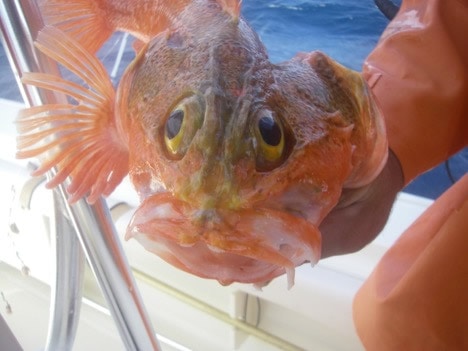
Black Belly Rosefish can be found from 600-1500 feet of water on every bottom type. These small fish are all over the place on the bottom and are quite tasty, very similar to Hogfish. They eat just about anything you put down there and there are no regulations for them either.
They look a lot like a small grouper but they are actually related to the Scorpion Fish. Not toxic or poisonous this fish is usually a bycatch when fishing for other species. It gets its name from the lining of the stomach cavity which is a shiny jet black. It is not uncommon to come up with a full stringer of these while fishing the deep water. They don’t fight very hard and a lot of times you don’t even know they are on the line.
Swordfish
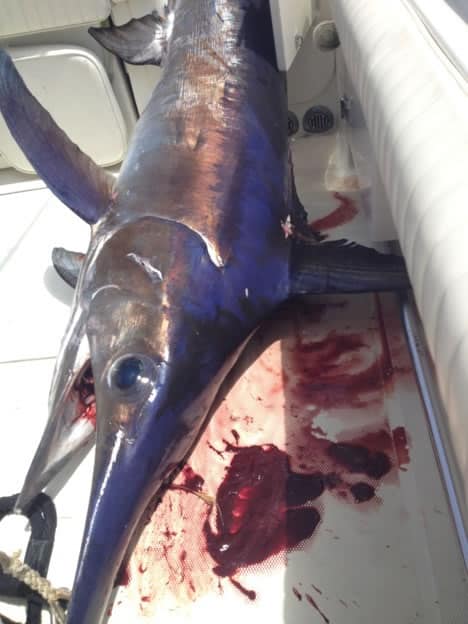
Swordfish can be found on ledges and humps from 1100-2600 feet of water. This is one of the greatest pelagic species that live in the ocean. It isn’t uncommon to catch one over 400 pounds. They will eat a variety of baits either on the bottom in the daytime or on the surface at night. Swordfishing in the daytime we fish on the bottom because that’s where their food is and they constantly eat 24 hours a day.
I use large J hooks with the bait sown on to ensure that they don’t knock the bait off as they feed. When Swordfish feed, they use their bill to kill or injure their prey before eating it. They swing their bill smacking the bait many times to subdue it. And for this reason we find by sowing the bait on it will still be on the hook after the Swordfish swats at it.
These fish once hooked take about an hour for every hundred pounds that they weigh to reel in. They have very soft mouths and we lose lots of fish from hooks tearing out. They are so powerful and can swim up to the surface from 2000 feet of water in a matter of minutes, which is a marvel because of the pressure change would kill most fish. Their meat is very sought after and one small fish can yield 50 pounds of meat, so just imagine a 300-600 pound fish yielding.

